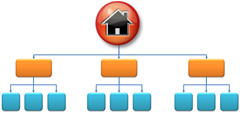Do not religiously follow the ‘3 click rule’. But also think about SEO
 How many clicks does it take your users to complete their tasks? How many give up before they complete? I have been at Microsoft for a good number of years now and have heard ‘the 3 click rule’ quoted on numerous occasions. Recent evidence suggests users are happy to go beyond 3 clicks. However before updating your sites and sending your users through many levels of links to reach their goal, also consider the flat site requirements for good SEO…
How many clicks does it take your users to complete their tasks? How many give up before they complete? I have been at Microsoft for a good number of years now and have heard ‘the 3 click rule’ quoted on numerous occasions. Recent evidence suggests users are happy to go beyond 3 clicks. However before updating your sites and sending your users through many levels of links to reach their goal, also consider the flat site requirements for good SEO…
A big thanks to Court Crawford, our gifted User Experience Lead at Microsoft for inspiring this post.
The 3 click rule…
…is simple…
Never require your users to go through more than 3 clicks to complete a task
The theory being that on average most users will give up after 3 clicks (presumably closing the browser, navigating to another site or simply walking away from the computer).
But is this really still true today? In the current online world of dynamic HTML 5 powered websites, Flash/Silverlight plugins, endless ‘Related content’ paths and rich media engaging web experiences, users expect to be guided through a website to complete their task, using multi-step processes which customise content and options as selections are made.
In fact, this post from uie.com suggest that the 3 click rule is simply a myth (not sure if this has always been the case, or rather a reflection of evolving typical web behaviour). Their research actually suggests that hardly anyone gives up after 3 clicks…
And that a larger number of clicks does not negatively effect user satisfaction…
Please view the full post for a full write up of the research
Replacing it with the 1 click rule…
This post on Grundyhome.com provides the ‘1 click rule’ as an alternative…
Every click or interaction should take the user closer to their goal while eliminating as much of the non-destination as possible.
and the corollary:
Avoid any interaction that eliminates the user’s intended goal.
So keeping the user ‘on side’ by making it clear how the requested action benefits their intended goal, removes any need to limit the inputs and effort required to complete a task. So long as the user knows where they are going, and as long as they are reassured of how each step gets them closer, they will stay on the path.
But don’t forget the SEO impact
But no matter how well designed your website is for your users to meet the 1 click rule, you also need to consider the SEO impact when considering the click depth of your site.
As mentioned in a recent blog post inspired by SEOMOZ, it is important to flatten your site structure effectively to ensure that important pages are 1 click away from high ranking pages (e.g. your homepage), and that other pages are 2, 3, 4, etc.. clicks away depending on the importance of the pages and the size of your site.
As per the ‘1 click rule’, having lots of goal focussing steps for your users is a good thing. Having 23 (as an example) pages for a user workflow indexed by search engines is probably NOT a good thing! A smart website design will ensure that the search engine entry pages for user tasks are optimised and close (in terms of clicks) to the homepage. The lower level pages which the users click through to complete a task, can use a solution such as the canonical tag, or on-page code (Javascript, Flash, Silverlight, HTML 5, etc…) to provide the users with a rich, interactive and multi click experience, whilst still ensuring that only a single strong ranking page is indexed by search engines.
Author: Chris Moore is a program manager from Microsoft working on Search Engine Optimisation. Follow him on Twitter
